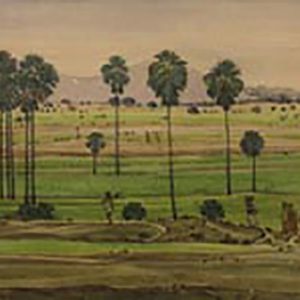Showing the single result
Born
1918
Education
No record.
Exhibitions
Exhibitions Indra Dugar was a poet of lonely landscapes. The Dugars are Jains and strict followers of the Tirthankaras (Saviours) who preached non violence and austerities to reach a perfect state of emancipation. Philosophically, it takes an extreme agnostic position. Both the monks and the laity practice vegetarianism. The Dugars migrated to Murshidabad, the seat of Mughal governor of Bengal, during the tenure of Murshid Kuli Khan, more than two hundred years ago, from Rajasthan. They finally settled in Jiagunj, Murshidabad district, became engaged in trading and business. Hira Chand Dugar’s father Surajmal was a successful entrepreneur like his forefathers and a very enlightened person. According to the information that Indra Dugar gave me, Surajmal was attracted to Rajasthani miniature painting, Jain miniatures of Western India, Jaipur Frescoes, and also Haveli paintings done on walls of rich merchant houses of the Marwari clan. Surajmal was so enamoured to visual art that he did not object to Hira Chand’s joining the Government School of Art and Craft, Kolkata, at the age of 16. He worked diligently under Ishwari Prasad Verma, a great exponent of the Patna ‘Kalam’ (Style) of provincial Mughal Art. In 1919 Nandalal Bose took over the charge of Kala Bhavan, Santiniketan from Asit Halder, the first head of the institution who, shortly afterwards, left to join as principal of Jaipur Maharaja Art School. Bose insisted Hira Chand to quit Government Art School and join Kala Bhavan. His classmates were Dhirendra Krishna Deb Barma, Krishnakinkar Ghosh and Ardhenduprasad Banerjee. In Santiniketan Hira Chand trained rigorously under Bose and took to landscape in right earnest. Bose was by then moving away from Abanindranath Tagore’s Schooling of Wash Painting and beginning to experiment with Gouche, Tempera and large Frescoes and mural on walls of Santiniketan. Hira Chand however preferred transparent watercolours. After completing the art course in Santiniketan, Hira Chand was recalled by Surajmal to take over the family business in Jiagunj. Soon after this he lost his wife. For twenty years he was so busy that he found no time to paint. Indra Dugar told me: “During a trip to Madhuban, Parasnath in Bihar, with my family, father accompanied us. For Jains it is a pilgrimage, an abode of Tirthankaras. You walked nine miles to reach the hilltop. There is a Jal mandir, a temple surrounded by water. We observe the rituals and I found time to paint in watercolours.” He does not break up the manifest real world but rearranges everything into his personal idiom. He does not disfigure but stylizes the parts into harmonic improvisations of visionary content. The onlooker is given an entry point with a familiar scene before the eyes. As the viewer observes, he is absorbed into an unfamiliar area of visual experience. Dugar does not carry the observer to the region of the abstract. There is a mystic hint of this. The viewer, if willing, may explore it all alone.

